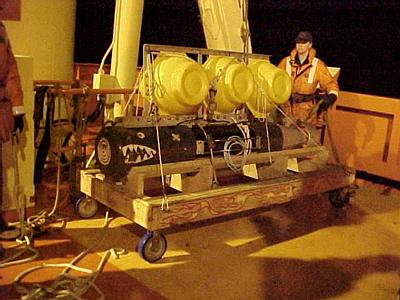11 March, 2000
--============_-1259323250==_ma============
Content-Type: text/plain; charset="us-ascii" ; format="flowed"
The weather continues to be stormy. Lots of rain and wind with the
temperature still at three degrees. Thank goodness for our "Mustang"
suits which cover us neck to ankle with windproof material and
insulation. They also help you to survive if you fall overboard. We
also wear knee high boots with steel toes for protection. With all
those clothes on it takes some extra effort to maneuver. The most
difficult part is most of what we need to do requires us to take our
gloves off. Our hands get really cold but the work still needs to be
done so we just dream of warmer times and continue on. As our chief
scientist, Dave DeMasters commented, "you pay dear for scientific
research in the Antarctic"
Our biggest challenge today was to deploy an underwater camera to be
towed behind the ship just above the bottom of the sea. It will
record the events there and we will be able to watch the tape upon
the camera's return on deck. The camera is housed in a waterproof
structure shaped like a missile which weighs about 540 pounds. A 900
pound weight is attached and pulled in front of the camera housing to
keep it held horizontal to the sea floor. Everything is attached by
cable to a winch on board the Gould so that the system can be raised
and lowered as the sea floor changes. A "pinger" is part of the
apparatus which sends location messages back to a computer on board
the ship to show the cameras relative position to the sea floor.
Principle Investigator, Craig Smith, monitors the computer the entire
time the camera is overboard and gives directions to the winch
operator as to whether to let out or take in cable to lower or raise
the system. Remember the ocean floor is approximately 500 meters
beneath the ship so all of the cameras maneuvers are happening a
long way away. It requires a lot of time and effort to do this but
the resulting film which shows us what the deep sea floor is like is
worth it.
Today is a frustrating experience though. After two hours work in
the middle of the dark night on rough seas, one of the switches on
the camera did not work correctly. When we viewed the film there was
nothing on it. We will hope for calmer weather tomorrow and try
again. We move our efforts to collecting other samples.
--============_-1259323250==_ma============
Content-Type: text/enriched; charset="us-ascii"
The weather continues to be stormy. Lots of rain and wind with the
temperature still at three degrees. Thank goodness for our "Mustang"
suits which cover us neck to ankle with windproof material and
insulation. They also help you to survive if you fall overboard. We
also wear knee high boots with steel toes for protection. With all
those clothes on it takes some extra effort to maneuver. The most
difficult part is most of what we need to do requires us to take our
gloves off. Our hands get really cold but the work still needs to be
done so we just dream of warmer times and continue on. As our chief
scientist, Dave DeMasters commented, "you pay dear for scientific
research in the Antarctic"
Our biggest challenge today was to deploy an underwater camera to be
towed behind the ship just above the bottom of the sea. It will record
the events there and we will be able to watch the tape upon the
camera's return on deck. The camera is housed in a waterproof
structure shaped like a missile which weighs about 540 pounds. A 900
pound weight is attached and pulled in front of the camera housing to
keep it held horizontal to the sea floor. Everything is attached by
cable to a winch on board the <italic>Gould<underline>
</underline></italic> so that the system can be raised and lowered as
the sea floor changes. A "pinger" is part of the apparatus which sends
location messages back to a computer on board the ship to show the
cameras relative position to the sea floor. Principle Investigator,
Craig Smith, monitors the computer the entire time the camera is
overboard and gives directions to the winch operator as to whether to
let out or take in cable to lower or raise the system. Remember the
ocean floor is approximately 500 meters beneath the ship so all of the
cameras maneuvers are happening a long way away. It requires a lot of
time and effort to do this but the resulting film which shows us what
the deep sea floor is like is worth it.
Today is a frustrating experience though. After two hours work in the
middle of the dark night on rough seas, one of the switches on the
camera did not work correctly. When we viewed the film there was
nothing on it. We will hope for calmer weather tomorrow and try again.
We move our efforts to collecting other samples.
--============_-1259323250==_ma============--

Readying the underwater camera system to be deployed overboard
Contact the TEA in the field at
.
If you cannot connect through your browser, copy the
TEA's e-mail address in the "To:" line of
your favorite e-mail package.
|
